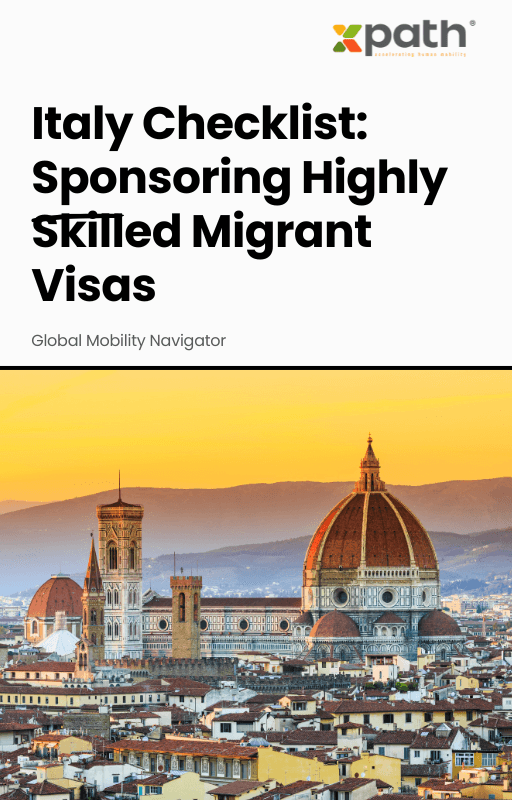Italy Checklist: Sponsoring Highly Skilled Migrant Visas
Grab a copy of a guide to international employee relocation
View E-bookHiring global talent fuels innovation and growth—until complex relocation processes stall your momentum. Manual visa tracking, compliance risks, and fragmented communication can delay starts by months, frustrate new hires, and overload HR teams. The solution? A tech-driven approach that transforms mobility from a bottleneck into a competitive advantage. Here’s how to streamline operations using platforms like xpath.global, which integrates automation, expertise, and scalability to keep global hiring agile.
Automation isn’t about replacing humans; it’s about eliminating errors in critical workflows. Manual document tracking or visa renewal processes often cause costly delays. For example:
🔸Deadline alerts for permit expirations prevent legal gaps.
🔸Centralized document hubs with auto-reminders ensure employees submit paperwork on time.
🔸Real-time dashboards give HR and employees visibility into case statuses, reducing back-and-forth queries.
xpath.global’s AI tools automate templated forms, bulk employee onboarding via RPA, and predictive timeline forecasting. One aerospace client cut HR onboarding time by 50% by migrating from spreadsheets to automated workflows.
Tip: Target repetitive tasks first—e.g., document collection or compliance checks—for maximum ROI.
Compliance is dynamic. A single missed tax registration or expired visa can trigger fines or deportation. Risks multiply with remote work, where roles/locations change frequently. Solutions include:
🔸GDPR-compliant platforms that encrypt data and automate renewal reminders for visas, permits, and contracts.
🔸Audit trails tracking policy adjustments across 183 countries, like salary thresholds or visa quotas.
🔸Integrated legal experts in xpath.global’s marketplace provide localized advice for high-risk regions.
For example, automated “expiry docs reminders” alert HR teams 60–90 days before deadlines, ensuring proactive renewals.
Relocation isn’t logistics—it’s a retention strategy. Confusing housing support or siloed immigration steps erode trust. Structure packages with:
🔸Transparency: Detailed cost projections for 11,000+ cities clarify housing/tax support.
🔸Holistic support: Access to vetted services (home searches, school placements, cultural training) via xpath.global’s marketplace.
🔸Employee-centric tech: Mobile apps like xpath.one let expats track case progress, store documents securely, and receive tax deadline alerts.
A Bosch Group HR manager highlights how unified platforms improve satisfaction: “Employees see real-time progress, reducing anxiety during moves”.
Visa denials, policy shifts, or family emergencies disrupt 30% of relocations. Mitigate risks by:
🔸Parallel processing: Launch housing searches while visas are pending using digital checklists.
🔸Remote-work buffers: Assign temporary remote roles if permits are delayed.
🔸Expert escalation paths: xpath.global’s vetted providers in 183 countries offer rapid response for emergencies like sudden document rejections.
Example: A tech firm used xpath.global’s timeline forecasting to reroute an employee’s relocation mid-process when host-country rules changed, avoiding a 3-month delay.
Siloed tools collapse under global expansion. HR needs unified platforms that:
🔸Centralize global data: Track assignments, costs, and compliance across entities in one dashboard.
🔸Integrate with HRIS: Sync employee data between xpath.global and systems like Workday.
🔸Offer elastic expertise: Access 60,000+ services for niche needs (e.g., EOR in Brazil or tax filing in Japan).
Global hiring accelerates when technology and expertise converge. Platforms like xpath.global replace fragmented tools with:
🔸End-to-end case management: From digital RFQs to real-time progress tracking.
🔸Predictive analytics: Cost projections and risk alerts for data-driven decisions.
🔸One ecosystem for all stakeholders: HR, employees, and service providers collaborate seamlessly.
“xpath.global isn’t just a tool—it’s a strategic backbone for global agility.” —HR Manager, Bosch Group
Ready to transform mobility from a hurdle into an advantage?
xpath.global combines AI-driven automation, a global expert network, and compliance safeguards to make relocation seamless. Book a demo to unlock frictionless global hiring.
*Covering 183 countries, 11,000+ cities, and 60,000+ vetted services—all in one GDPR-secure platform.*
How long does the typical relocation process take?
Timelines vary by country and visa type, but a full relocation usually takes 2–6 months, including paperwork, housing, and logistics.
Can I hire someone remotely first, then relocate them?
Yes—many companies start with remote onboarding while immigration is underway. Just ensure legal work permissions align with local labor laws.
What’s included in a typical relocation package?
It varies, but most include flights, temporary housing, moving assistance, and sometimes school or spouse support.
How do I keep employees informed during the immigration process?
Use employee-facing platforms with real-time updates, case dashboards, and direct communication to reduce anxiety and improve transparency.
Is it better to outsource global mobility or build in-house?
For growing companies, outsourcing to a provider like Jobbatical offers more speed, compliance, and scalability than most in-house setups can match.
What happens if an employee’s visa gets delayed?
Plan contingencies such as remote work extensions, deadline adjustments, and fast-tracked escalations with your immigration partner.
Ready to transform your mobility program? Explore xpath.global’s solutions.

Italy Checklist: Sponsoring Highly Skilled Migrant Visas
Grab a copy of a guide to international employee relocation
View E-book